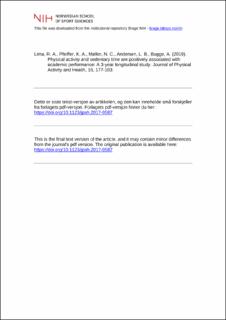Physical activity and sedentary time are positively associated with academic performance: A 3-year longitudinal study
Lima, Rodrigo Antunes; Pfeiffer, Karin Allor; Møller, Niels Christian; Andersen, Lars Bo; Bugge, Anna
Peer reviewed, Journal article
Accepted version
Permanent lenke
https://hdl.handle.net/11250/2646993Utgivelsesdato
2019Metadata
Vis full innførselSamlinger
- Artikler / Articles [2119]
- Publikasjoner fra Cristin [1107]
Originalversjon
Journal of Physical Activity and Health. 2019, 16(3), 177-183. 10.1123/jpah.2017-0587Sammendrag
Background: To analyze the longitudinal association between academic performance and moderate to vigorous physical activity (MVPA), vigorous physical activity (VPA), and sedentary (SED) in a 3-year longitudinal study. A secondary aim was to determine whether MVPA and VPA were indirectly related with academic performance via waist circumference (WC). Methods: Physical activity (PA) and SED were measured by accelerometers. Academic performance was assessed by national tests in Danish and Math. Structural equation modeling was performed to evaluate whether MVPA, VPA, and SED were associated with academic performance and the potential PA–academic performance indirect relationship via WC. Results: MVPA and VPA were associated with academic performance, mediated via WC (β = 0.036; 95% confidence interval [CI], 0.002 to 0.070 and β = 0.096; 95% CI, 0.027 to 0.164, respectively). SED was directly associated with academic performance (β = 0.124; 95% CI, 0.030 to 0.217, MVPA model and β = 0.132; 95% CI, 0.044 to 0.221, VPA model). WC was negatively associated with academic performance. Conclusions: Both PA and SED time were positively associated with academic performance. Based on this, PA should be encouraged in children and youth not only to promote physical health but also to promote academic performance. Future studies should distinguish between school-related SED and other SED activities and their relationship with academic performance.
